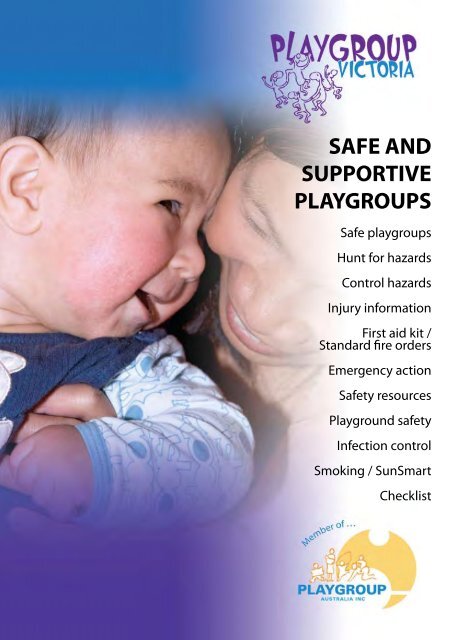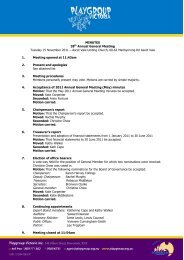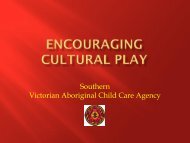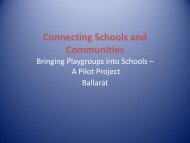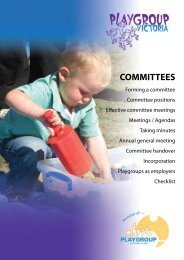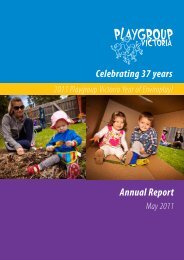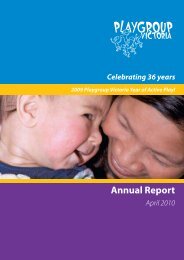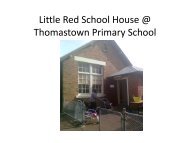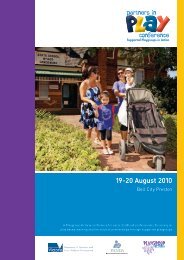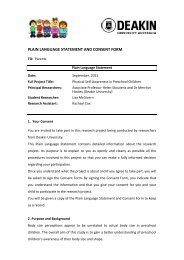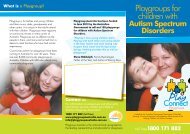to view ESSENTIAL READING on this module - Playgroup Victoria
to view ESSENTIAL READING on this module - Playgroup Victoria
to view ESSENTIAL READING on this module - Playgroup Victoria
You also want an ePaper? Increase the reach of your titles
YUMPU automatically turns print PDFs into web optimized ePapers that Google loves.
SAFE AND<br />
SUPPORTIVE<br />
PLAYGROUPS<br />
Safe playgroups<br />
Hunt for hazards<br />
C<strong>on</strong>trol hazards<br />
Injury informati<strong>on</strong><br />
First aid kit /<br />
Standard fire orders<br />
Emergency acti<strong>on</strong><br />
Safety resources<br />
Playground safety<br />
Infecti<strong>on</strong> c<strong>on</strong>trol<br />
Smoking / SunSmart<br />
Checklist
SAFE AND SUPPORTIVE PLAYGROUPS<br />
Safe playgroups<br />
Creating a safe playgroup<br />
Even if we give our playgroup-aged children loving<br />
care and close supervisi<strong>on</strong> we cannot always keep<br />
them from harm.<br />
Children can still trip, fall, bleed, bruise, get scratched,<br />
cut, burnt or bitten.<br />
But whether your playgroup is in homes or a public<br />
facility, you have a resp<strong>on</strong>sibility <str<strong>on</strong>g>to</str<strong>on</strong>g> provide a safe,<br />
healthy envir<strong>on</strong>ment for children. It is the child’s right<br />
<str<strong>on</strong>g>to</str<strong>on</strong>g> be supervised at all times.<br />
We can take positive acti<strong>on</strong> <str<strong>on</strong>g>to</str<strong>on</strong>g> lessen the chances of or<br />
s<str<strong>on</strong>g>to</str<strong>on</strong>g>p more serious injuries occurring.<br />
How many families make a safe<br />
playgroup<br />
For home playgroups <strong>Playgroup</strong> Vic<str<strong>on</strong>g>to</str<strong>on</strong>g>ria recommends<br />
around 6-8 families, for hall playgroups 10-15 families.<br />
Overcrowding can increase the risk of an accident<br />
occurring. C<strong>on</strong>sider the size of your meeting place and<br />
how many families are comfortable indoors <strong>on</strong> a wet<br />
day.<br />
Children's Services Regulati<strong>on</strong>s recommend 3.3 square<br />
metres per child for an indoor play space. <strong>Playgroup</strong>s<br />
are not bound by these regulati<strong>on</strong>s but are wise <str<strong>on</strong>g>to</str<strong>on</strong>g> use<br />
them as a guide.<br />
Decide, as a group, <strong>on</strong> a safe number of enrolled<br />
families for your playgroup. Take in<str<strong>on</strong>g>to</str<strong>on</strong>g> account the size<br />
of the venue, ages of the children and number of<br />
families with more than <strong>on</strong>e child attending.<br />
If you feel your playgroup is getting <str<strong>on</strong>g>to</str<strong>on</strong>g>o large <str<strong>on</strong>g>to</str<strong>on</strong>g> be safe:<br />
• start a new playgroup sessi<strong>on</strong><br />
• make a waiting list, or<br />
• refer families <str<strong>on</strong>g>to</str<strong>on</strong>g> other local playgroups.<br />
Develop a playgroup safety policy<br />
Involve every<strong>on</strong>e in making decisi<strong>on</strong>s about safety<br />
issues then put them in<str<strong>on</strong>g>to</str<strong>on</strong>g> a safety policy. Display your<br />
policy and make new playgroup members aware of it.<br />
Writing a safety policy<br />
1. Begin with a str<strong>on</strong>g statement defining safety and<br />
outlining your playgroup’s commitment <str<strong>on</strong>g>to</str<strong>on</strong>g> safety.<br />
Define who is resp<strong>on</strong>sible for safety regarding:<br />
− supervisi<strong>on</strong> of children<br />
− <str<strong>on</strong>g>to</str<strong>on</strong>g>ys and equipment<br />
− children going <str<strong>on</strong>g>to</str<strong>on</strong>g> the <str<strong>on</strong>g>to</str<strong>on</strong>g>ilet<br />
− fences, gates and doors<br />
− the playground and fixed equipment<br />
− car parking and transporting children<br />
− other issues related <str<strong>on</strong>g>to</str<strong>on</strong>g> play activities.<br />
2. List playgroup guidelines regarding:<br />
− infectious diseases<br />
− SunSmart<br />
− smoking<br />
− kitchen issues and hot drinks<br />
− other issues specific <str<strong>on</strong>g>to</str<strong>on</strong>g> your venue.<br />
3. Include emergency evacuati<strong>on</strong> procedures in cases<br />
of fire or trauma. See ‘Standard fire orders for<br />
playgroups’ <strong>on</strong> page 66.<br />
4. State where the following are kept and who is<br />
resp<strong>on</strong>sible for:<br />
− emergency numbers for fire<br />
− enrolment forms with pers<strong>on</strong>al details should<br />
any<strong>on</strong>e be injured or traumatised<br />
− first aid kit<br />
− accident, incident and injury book.<br />
5. Define how members can raise and report safety<br />
c<strong>on</strong>cerns and how these c<strong>on</strong>cerns will be handled.<br />
A safety policy is a living document. Regularly revise<br />
and update it <str<strong>on</strong>g>to</str<strong>on</strong>g> ensure your practices are c<strong>on</strong>sistent<br />
with your policy.<br />
Sharing the resp<strong>on</strong>sibility<br />
Each parent and caregiver attending a playgroup must<br />
be resp<strong>on</strong>sible for the welfare and safety of the<br />
child/ren they bring. There is also a group<br />
resp<strong>on</strong>sibility <str<strong>on</strong>g>to</str<strong>on</strong>g> ensure every child is safe.<br />
Keeping <strong>this</strong> in mind , remember that playgroups need<br />
<str<strong>on</strong>g>to</str<strong>on</strong>g> keep a balance between being safe and allowing the<br />
children <str<strong>on</strong>g>to</str<strong>on</strong>g> take the risks necessary <str<strong>on</strong>g>to</str<strong>on</strong>g> develop new<br />
skills.<br />
62 <strong>Playgroup</strong> Manual
SAFE AND SUPPORTIVE PLAYGROUPS<br />
Hunt for hazards<br />
Drowning<br />
• Pool, p<strong>on</strong>d, river, dam<br />
• Bath, <str<strong>on</strong>g>to</str<strong>on</strong>g>ilet, bucket, unsupervised water play<br />
equipment<br />
• Gully trap c<strong>on</strong>taining water or liquids<br />
Children can drown in as little as five centimetres of<br />
water.<br />
Falls<br />
• Hole, well or trench over <strong>on</strong>e metre deep<br />
• Stairway, fence, tree, ladder, play equipment or<br />
furniture over 1.5 metres<br />
• Rocks, c<strong>on</strong>crete or hard surface within <strong>on</strong>e metre<br />
of play equipment<br />
• Uneven or cracked c<strong>on</strong>crete pathways<br />
Burns and scalds<br />
• Unguarded heaters or open fireplaces<br />
• Flammable liquids, matches or lighters<br />
• Cooking appliances within reach<br />
• Hot water or cups of tea or coffee<br />
• Cigarettes<br />
• Hot water taps – reduce the temperature of hot<br />
water<br />
• Barbecues at sausage sizzles<br />
Traffic accidents<br />
• Unfenced outdoor areas<br />
• Car parks<br />
• Doors left open by members or visi<str<strong>on</strong>g>to</str<strong>on</strong>g>rs <str<strong>on</strong>g>to</str<strong>on</strong>g> streets<br />
or car parks<br />
Electrocuti<strong>on</strong><br />
• Electrical power points not protected by covers<br />
• Cords and appliances in children's reach<br />
Suffocati<strong>on</strong><br />
• Plastic bags<br />
• Refrigera<str<strong>on</strong>g>to</str<strong>on</strong>g>rs, cupboards<br />
Pois<strong>on</strong>ing<br />
• Medicati<strong>on</strong>s or other dangerous substances left<br />
within child’s reach or in handbags<br />
• Cigarette butts in ash trays<br />
• Mouse or insect pois<strong>on</strong>s/sprays<br />
• Garden, household, garage products<br />
• Toxic paints, glues, cray<strong>on</strong>s, markers<br />
• Pois<strong>on</strong>ous plants<br />
• Disinfectants, washing liquids used as a bubble<br />
mixture<br />
Choking<br />
• Objects smaller than 32mm x 32mm e.g. cray<strong>on</strong>s,<br />
small parts of <str<strong>on</strong>g>to</str<strong>on</strong>g>ys, small objects found in<br />
handbags left within reach of children<br />
• Polystyrene or polystyrene beads which, if inhaled<br />
or ingested, are not detectable <strong>on</strong> X-ray<br />
• Drawing pins, small coins<br />
• Deflated ballo<strong>on</strong>s or ballo<strong>on</strong> pieces<br />
Bites and stings<br />
• Animals including pets, spiders, snakes, wasps<br />
and bees<br />
Cuts and crushes<br />
• N<strong>on</strong>-safety low glass in doors or windows<br />
• Hooks, scissors, splinters, nails, hypodermic<br />
needles<br />
• Knives, glass bottles, <str<strong>on</strong>g>to</str<strong>on</strong>g>ols<br />
• Broken <str<strong>on</strong>g>to</str<strong>on</strong>g>ys or equipment, sharp table corners<br />
• Unstable appliances, furniture, equipment that<br />
could fall or has hinges<br />
• Doors or windows left open by caregivers or<br />
parents that could slam shut<br />
• Unprotected joints and hinges<br />
• Chairs, tables or other furniture stacked against a<br />
wall<br />
• Broken or inappropriate furniture s<str<strong>on</strong>g>to</str<strong>on</strong>g>red in the<br />
play room<br />
Entrapment<br />
• Cords l<strong>on</strong>ger than 30cm, rope, clothesline<br />
• Furniture, <str<strong>on</strong>g>to</str<strong>on</strong>g>ys or play equipment that could<br />
entrap a child's fingers, head or limb<br />
Gunshot wounds<br />
• Firearms or ammuniti<strong>on</strong><br />
<strong>Playgroup</strong> Manual 63
SAFE AND SUPPORTIVE PLAYGROUPS<br />
C<strong>on</strong>trol hazards<br />
Hazard c<strong>on</strong>trol<br />
Always make it part of your regular routine <str<strong>on</strong>g>to</str<strong>on</strong>g> check<br />
all indoor and outdoor play areas for possible hazards.<br />
This is particularly necessary when other groups share<br />
the playgroup room. If you find a hazard remove,<br />
repair, replace or restrict access.<br />
Minimise the risks<br />
If hazards cannot be removed, put up barriers <str<strong>on</strong>g>to</str<strong>on</strong>g><br />
protect children. Use fences, gates, guards, doors,<br />
covers, locks, child restraints, c<strong>on</strong>tainers and<br />
cupboards.<br />
Keep dangerous objects at least 1.5m above floor level<br />
and remove anything children could use <str<strong>on</strong>g>to</str<strong>on</strong>g> climb <str<strong>on</strong>g>to</str<strong>on</strong>g><br />
that height. Latches <strong>on</strong> gates and doors should be more<br />
than 1.5m high. Gates should be self closing and self<br />
locking.<br />
Place a ‘Hold My Hand’ sign <strong>on</strong> the inside of the gate.<br />
Signs available from Uniform Safety Signs, call 9354<br />
0016.<br />
Be prepared<br />
Have ph<strong>on</strong>e access<br />
Display your emergency acti<strong>on</strong> plan and emergency<br />
ph<strong>on</strong>e numbers in a prominent positi<strong>on</strong>. See<br />
‘Emergency acti<strong>on</strong>’ <strong>on</strong> page 67 and the checklist <strong>on</strong><br />
page 74. Regularly check that the informati<strong>on</strong> is<br />
current.<br />
If a ph<strong>on</strong>e is not available at the playgroup venue<br />
arrange for a member <str<strong>on</strong>g>to</str<strong>on</strong>g> carry their mobile ph<strong>on</strong>e or<br />
make arrangements with nearby residents.<br />
Have a first aid kit<br />
Be sure <str<strong>on</strong>g>to</str<strong>on</strong>g> have a playgroup first aid kit available.<br />
Regularly replace used and out-of-date items.<br />
Suitable kits can be purchased from St John<br />
Ambulance or Kidsafe. See ‘Safety resources’ <strong>on</strong> page<br />
68 and ‘Recommended c<strong>on</strong>tents for a general first aid<br />
kit’ <strong>on</strong> page 66.<br />
C<strong>on</strong>sider having first aid charts displayed and some<strong>on</strong>e<br />
in the group trained <str<strong>on</strong>g>to</str<strong>on</strong>g> handle emergencies.<br />
St John Ambulance and the safety centre at<br />
Melbourne’s Royal Children's Hospital run first aid<br />
courses. See page 68 for ph<strong>on</strong>e numbers.<br />
Have a fire evacuati<strong>on</strong> plan<br />
Use the standard fire orders for playgroups <strong>on</strong> page 66<br />
<str<strong>on</strong>g>to</str<strong>on</strong>g> write an emergency acti<strong>on</strong> plan for your playgroup.<br />
Display the plan and regularly practise the fire drill.<br />
Know where all fire extinguishers are and be sure<br />
every<strong>on</strong>e knows how <str<strong>on</strong>g>to</str<strong>on</strong>g> use them. Check that<br />
emergency exits are clearly labelled and not blocked.<br />
External fires<br />
If you are in a high bushfire danger area have a policy<br />
regarding cancelling the playgroup <strong>on</strong> high fire danger<br />
days.<br />
Record<br />
Have a book available <str<strong>on</strong>g>to</str<strong>on</strong>g> record any incidents or<br />
injuries while they are fresh in members’ minds. If an<br />
insurance claim eventuates <strong>this</strong> informati<strong>on</strong> is very<br />
important.<br />
When recording an incident include dates, times,<br />
place, people present, acti<strong>on</strong> taken and signatures.<br />
Two adults should complete a signed, eye witness<br />
account wherever possible. See ‘Accident, incident or<br />
injury record’ <strong>on</strong> page 130.<br />
Plan emergency transport<br />
Plan ahead how you would transport an adult or child<br />
in an emergency situati<strong>on</strong>.<br />
Keep numbers manageable<br />
Ask families <str<strong>on</strong>g>to</str<strong>on</strong>g> sign in and out in your attendance book<br />
so that in an emergency you can quickly see if every<strong>on</strong>e<br />
is accounted for.<br />
Avoid overcrowding as it can cause c<strong>on</strong>fusi<strong>on</strong> in an<br />
emergency.<br />
64 <strong>Playgroup</strong> Manual
SAFE AND SUPPORTIVE PLAYGROUPS<br />
Injury informati<strong>on</strong><br />
Emergency acti<strong>on</strong> for playgroups<br />
St John Ambulance has developed a training operati<strong>on</strong><br />
that follows the sequence D.R.A.B.C.<br />
D for danger – protect yourself and others from any<br />
further danger.<br />
R for resp<strong>on</strong>se – check <str<strong>on</strong>g>to</str<strong>on</strong>g> see if the pers<strong>on</strong> is c<strong>on</strong>scious<br />
and able <str<strong>on</strong>g>to</str<strong>on</strong>g> resp<strong>on</strong>d.<br />
A for airways – if the pers<strong>on</strong> is unc<strong>on</strong>scious check<br />
their airways are not blocked. Place the pers<strong>on</strong> <strong>on</strong> their<br />
side and tilt their head back and slightly down. Open<br />
their mouth and remove any blockages.<br />
B for breathing – if the pers<strong>on</strong> is not breathing apply<br />
mouth <str<strong>on</strong>g>to</str<strong>on</strong>g> mouth resuscitati<strong>on</strong>. Place the pers<strong>on</strong> <strong>on</strong><br />
their back. Tilt their head back supporting jaw. Blow<br />
with nose pinched until chest rises. Babies: puff in<str<strong>on</strong>g>to</str<strong>on</strong>g><br />
mouth and nose. Give five mouth <str<strong>on</strong>g>to</str<strong>on</strong>g> mouth breaths.<br />
C for circulati<strong>on</strong> – if the pers<strong>on</strong> is not breathing, check<br />
for a heartbeat (pulse). If there is no pulse give CPR.<br />
C<strong>on</strong>sider having some<strong>on</strong>e at your playgroup trained <str<strong>on</strong>g>to</str<strong>on</strong>g><br />
do first aid.<br />
First aid for comm<strong>on</strong> playgroup<br />
injuries<br />
Bee sting When bees sting they usually leave behind a<br />
tiny venom sack. Remove <strong>this</strong> by scraping it sideways<br />
with a fingernail or the side of a knife. Wipe the area<br />
clean. Apply a cold compress. Watch for signs of<br />
allergic reacti<strong>on</strong>s.<br />
European wasp sting Wash the sting area clean.<br />
Apply cold compress. If there are signs of allergic<br />
reacti<strong>on</strong> seek medical help urgently.<br />
Bites For life threatening bites from venomous snakes<br />
or funnel web spiders apply a pressure immobilisati<strong>on</strong><br />
bandage over the bitten area and around the limb. Get<br />
medical attenti<strong>on</strong> urgently.<br />
Choking If you can see the object, hook it out with<br />
your fingers, otherwise d<strong>on</strong>’t attempt. Encourage child<br />
<str<strong>on</strong>g>to</str<strong>on</strong>g> breathe slowly and calmly and cough <str<strong>on</strong>g>to</str<strong>on</strong>g> remove the<br />
object. If they cease <str<strong>on</strong>g>to</str<strong>on</strong>g> breathe lie them down with<br />
their head low and give three or four sharp blows<br />
between the shoulder blades. If <strong>this</strong> doesn’t work try<br />
mouth <str<strong>on</strong>g>to</str<strong>on</strong>g> mouth resuscitati<strong>on</strong> <str<strong>on</strong>g>to</str<strong>on</strong>g> blow air past or blow<br />
obstructi<strong>on</strong> out.<br />
Bleeding Apply direct pressure.<br />
Open wounds C<strong>on</strong>trol bleeding with a clean dressing<br />
pad, clean the wound, apply a sterile dressing.<br />
Abrasi<strong>on</strong>s Clean the abrasi<strong>on</strong> with sterile gauze<br />
soaked in cool boiled water or wash under running tap<br />
water. Apply antiseptic according <str<strong>on</strong>g>to</str<strong>on</strong>g> directi<strong>on</strong>s <strong>on</strong> the<br />
label. Gently apply a n<strong>on</strong>-stick dressing.<br />
Burns Apply cold water for 10 minutes. Apply sterile<br />
n<strong>on</strong>-stick dressing.<br />
Shock Lie the pers<strong>on</strong> down and protect from cold.<br />
Fractures Immobilise the injured part. Seek medical<br />
help as so<strong>on</strong> as possible.<br />
First aid advice for pois<strong>on</strong>ing<br />
Pois<strong>on</strong> swallowed Pick up c<strong>on</strong>tainer and any residue<br />
and take <str<strong>on</strong>g>to</str<strong>on</strong>g> ph<strong>on</strong>e.<br />
Call Pois<strong>on</strong>s Informati<strong>on</strong> Centre and follow advice.<br />
Pois<strong>on</strong> in eye Flood the eye with water poured from a<br />
cup held two <str<strong>on</strong>g>to</str<strong>on</strong>g> three centimetres from the eye and<br />
repeat for 10 <str<strong>on</strong>g>to</str<strong>on</strong>g> 15 minutes.<br />
Call the Pois<strong>on</strong>s Informati<strong>on</strong> Centre and follow advice.<br />
Pois<strong>on</strong> inhaled Immediately get the pers<strong>on</strong> <str<strong>on</strong>g>to</str<strong>on</strong>g> fresh<br />
air, open doors and windows.<br />
Call the Pois<strong>on</strong>s Informati<strong>on</strong> Centre and follow advice.<br />
Pois<strong>on</strong> <strong>on</strong> skin Remove c<strong>on</strong>taminated clothing and<br />
flood skin with water. Wash gently with soap and<br />
water, rinse.<br />
Call the Vic<str<strong>on</strong>g>to</str<strong>on</strong>g>rian Pois<strong>on</strong>s Informati<strong>on</strong> Centre and<br />
follow advice or visit www.austin.org.au/pois<strong>on</strong>s.<br />
C<strong>on</strong>tact Vic<str<strong>on</strong>g>to</str<strong>on</strong>g>rian Pois<strong>on</strong>s Informati<strong>on</strong><br />
Centre in an emergency<br />
• Call 13 11 26.<br />
• State the name of the pois<strong>on</strong> and amount taken.<br />
• State when swallowed or c<strong>on</strong>tacted.<br />
• State child's age and c<strong>on</strong>diti<strong>on</strong>.<br />
• Follow the advice given.<br />
If the victim has collapsed, s<str<strong>on</strong>g>to</str<strong>on</strong>g>pped breathing, is fitting<br />
or is suffering an anaphylactic reacti<strong>on</strong>, ring 000 for an<br />
ambulance. Do NOT ring the Pois<strong>on</strong>s Informati<strong>on</strong><br />
Centre.<br />
<strong>Playgroup</strong> Manual 65
SAFE AND SUPPORTIVE PLAYGROUPS<br />
First aid kit/<br />
Standard fire orders<br />
Recommended c<strong>on</strong>tents for a general<br />
first aid kit<br />
1 x 50 pack adhesive dressing strips<br />
2 x triangular bandages<br />
1 x small c<strong>on</strong>forming elastic bandage (5cm wide)<br />
1 x medium c<strong>on</strong>forming elastic bandage (7.5cm wide)<br />
2 x medium crepe bandage (7.5cm wide)<br />
2 x eye pads<br />
2 x small wound dressing (no.13)<br />
2 x medium wound dressing (no.14)<br />
2 x medium combine dressing pads (9 x 20cm)<br />
2 x large combine dressing pads (20 x 20cm)<br />
3 x medium gauze dressing (7.5 x 7.5cm)<br />
2 x small Melolin dressing (5 x 5cm)<br />
Adhesive tape (2.5cm wide – preferably Micropore)<br />
4 x Sterowipes (alcohol swabs) or iodine sachets<br />
4 x saline Steritubes (minimum 10ml)<br />
1 x sterile eyewash bottle<br />
1 x pair scissors<br />
1 x pair tweezers<br />
1 x 12 pack safety pins<br />
2 x disposable gloves (medium and large)<br />
1 x resuscitati<strong>on</strong> mask or face shield<br />
3 Individually wrapped hand <str<strong>on</strong>g>to</str<strong>on</strong>g>wels<br />
3 Plastic bags (150mm x 200mm)<br />
1 Thermometer<br />
1 Insect repellent<br />
1 Sunscreen<br />
First aid booklet<br />
Note pad and pencil.<br />
Standard fire orders for playgroups<br />
Up<strong>on</strong> discovery of a fire<br />
1. Assist any<strong>on</strong>e in immediate danger, <strong>on</strong>ly if safe <str<strong>on</strong>g>to</str<strong>on</strong>g><br />
do so.<br />
2. Group coordina<str<strong>on</strong>g>to</str<strong>on</strong>g>rs and assistants <str<strong>on</strong>g>to</str<strong>on</strong>g> check all<br />
areas including <str<strong>on</strong>g>to</str<strong>on</strong>g>ilets, s<str<strong>on</strong>g>to</str<strong>on</strong>g>rerooms, kitchen and<br />
close doors after check. Ensure all children are<br />
accounted for. Retrieve attendance book <strong>on</strong>ly if<br />
safe <str<strong>on</strong>g>to</str<strong>on</strong>g> do so.<br />
3. Ring fire brigade <strong>on</strong> 000 and alert other building<br />
users.<br />
4. Evacuate <str<strong>on</strong>g>to</str<strong>on</strong>g> designated assembly area.<br />
5. Remain at assembly area and ensure all are<br />
accounted for using attendance book. Do not<br />
return <str<strong>on</strong>g>to</str<strong>on</strong>g> the building until an all clear for your<br />
return has been given.<br />
Bushfire<br />
<strong>Playgroup</strong> Vic<str<strong>on</strong>g>to</str<strong>on</strong>g>ria suggests that playgroups in<br />
bushfire risk areas:<br />
• become familiar with CFA bushfire preparedness<br />
and survival guidelines<br />
• become familiar with CFA scale of fire dinger<br />
ratings<br />
• develop a plan of acti<strong>on</strong> according <str<strong>on</strong>g>to</str<strong>on</strong>g> CFA<br />
guidelines that includes:<br />
− a clear statement as <str<strong>on</strong>g>to</str<strong>on</strong>g> the level of fire danger<br />
when playgroup will be cancelled<br />
− encouragement for playgroup members <str<strong>on</strong>g>to</str<strong>on</strong>g><br />
have a pers<strong>on</strong>al bushfire survival plan<br />
− a clear statement that informs playgroup<br />
members <str<strong>on</strong>g>to</str<strong>on</strong>g> act resp<strong>on</strong>sibly during danger<br />
periods and stay away from playgroup if they<br />
believe the risk is <str<strong>on</strong>g>to</str<strong>on</strong>g>o great<br />
− being alert and stay informed of weather<br />
c<strong>on</strong>diti<strong>on</strong>s in your area.<br />
It is also important that playgroups have a clear<br />
understanding of venue owner’s emergency plans. It is<br />
important that all families know where emergency<br />
equipment is s<str<strong>on</strong>g>to</str<strong>on</strong>g>red and that the equipment is<br />
periodically checked and in good working order.<br />
The Vic<str<strong>on</strong>g>to</str<strong>on</strong>g>rian Department of Educati<strong>on</strong> and Early<br />
Childhood Development (DEECD) have informati<strong>on</strong><br />
<strong>on</strong> best practice and an assessment <str<strong>on</strong>g>to</str<strong>on</strong>g>ol <str<strong>on</strong>g>to</str<strong>on</strong>g> asses risk at<br />
your playgroup venue. For more informati<strong>on</strong> c<strong>on</strong>tact:<br />
• the CFA <strong>on</strong> 9262 8444 or visit<br />
www.cfa.vic.gov.au<br />
• the MFB <strong>on</strong> 9662 2311 or visit<br />
www.mfb.vic.gov.au<br />
• DEECD <strong>on</strong> 9637 2000 or visit<br />
www.educati<strong>on</strong>.vic.gov.au.<br />
66 <strong>Playgroup</strong> Manual
SAFE AND SUPPORTIVE PLAYGROUPS<br />
Emergency acti<strong>on</strong><br />
Emergency numbers<br />
The closest ph<strong>on</strong>e for playgroup use is at:<br />
____________________________________________________<br />
Members with mobile ph<strong>on</strong>e and their numbers:<br />
Ambulance<br />
Ph<strong>on</strong>e: ____________________________________________<br />
Fire stati<strong>on</strong><br />
Ph<strong>on</strong>e: ____________________________________________<br />
Pois<strong>on</strong>s Informati<strong>on</strong> Centre<br />
Ph<strong>on</strong>e: ____________________________________________<br />
Police<br />
Ph<strong>on</strong>e: ____________________________________________<br />
• Give the exact locati<strong>on</strong>.<br />
• State the number of casualties.<br />
• State the severity of the injury or illness.<br />
• Do not hang up until the opera<str<strong>on</strong>g>to</str<strong>on</strong>g>r has c<strong>on</strong>firmed<br />
they have all the necessary informati<strong>on</strong>, i.e. never<br />
hang up first.<br />
Keep <strong>this</strong> informati<strong>on</strong> <strong>on</strong> display near the<br />
ph<strong>on</strong>e<br />
• <strong>Playgroup</strong> address<br />
_______________________________________________<br />
• Nearest intersecting street<br />
_______________________________________________<br />
• Melway map reference<br />
_______________________________________________<br />
• <strong>Playgroup</strong> c<strong>on</strong>tact number<br />
_______________________________________________<br />
Hospital<br />
Ph<strong>on</strong>e: ____________________________________________<br />
Local doc<str<strong>on</strong>g>to</str<strong>on</strong>g>r<br />
Ph<strong>on</strong>e: ____________________________________________<br />
Our first aid kit is kept:<br />
____________________________________________________<br />
Our accident book is kept:<br />
____________________________________________________<br />
Parent emergency ph<strong>on</strong>e numbers are kept:<br />
____________________________________________________<br />
To call an ambulance<br />
Ensure there is some<strong>on</strong>e <str<strong>on</strong>g>to</str<strong>on</strong>g> stay with the patient at all<br />
times; a sec<strong>on</strong>d pers<strong>on</strong> should ph<strong>on</strong>e for help.<br />
• Call the local ambulance:<br />
______________________________________________<br />
<strong>Playgroup</strong> Manual 67
SAFE AND SUPPORTIVE PLAYGROUPS<br />
Safety resources<br />
References and resources<br />
Community health centres<br />
See ph<strong>on</strong>e listing under ‘Business listings’ in White<br />
Pages or visit www.whitepages.com.au.<br />
The Department of Educati<strong>on</strong> and Early<br />
Childhood Development<br />
For Children’s Services Regulati<strong>on</strong>s 2009 visit<br />
www.educati<strong>on</strong>.vic.gov.au/licensedchildservices or<br />
call 1300 370 415. See ‘Sick children’ <strong>on</strong> page 72.<br />
Kidsafe resources<br />
Kidsafe, Child Accident Preventi<strong>on</strong> Foundati<strong>on</strong> of<br />
Australia, 221 Burwood Highway, Burwood, call 9251<br />
7725 or visit www.kidsafevic.com.au<br />
Informati<strong>on</strong> sheets<br />
• Choosing a helmet for your child<br />
• Christmas wheels<br />
• Christmas <str<strong>on</strong>g>to</str<strong>on</strong>g>ys<br />
• Fire and burns<br />
• Hot cars<br />
• Pedestrian injuries<br />
• Scalds<br />
• Ten key facts about child safety<br />
• Toddlers and water safety<br />
• Nursery equipment<br />
• About Kidsafe’s Achievements<br />
• 2007 Kidsafe and Archicentre home safety<br />
checklist<br />
Resources<br />
• SafeKIDS Now fact sheets, Birth – 9 mths, 9 –18<br />
mths, 18 mths – 3½ yrs, 3½ – 5 yrs and Farm<br />
Safety<br />
• Pedestrian Safety brochure<br />
• A Parent’s Guide <str<strong>on</strong>g>to</str<strong>on</strong>g> Kidsafe Homes booklet<br />
• Playspace Resource Kit<br />
• First Aid for Kids Interactive CD<br />
• ‘Do Not Leave Children in Cars’ Traffic Sign<br />
Maternal and child health centres<br />
See ph<strong>on</strong>e listings under individual councils in White<br />
Pages ph<strong>on</strong>e book or visit www.whitepages.com.au.<br />
Royal Children’s Hospital Child Health and<br />
Safety Resources Centre<br />
The Royal Children’s Hospital Child Health and Safety<br />
Resource Centre at The Royal Children’s Hospital,<br />
Fleming<str<strong>on</strong>g>to</str<strong>on</strong>g>n Road, Parkville offers first aid courses,<br />
safety devices, <str<strong>on</strong>g>to</str<strong>on</strong>g>ys and playgroup safety informati<strong>on</strong>.<br />
Call 9345 6429 or visit www.rch.org.au/safetycentre<br />
Safety items<br />
• Child proof cupboard and drawer locks<br />
• Pois<strong>on</strong>s cabinet<br />
• Door or stair barriers<br />
• Door guards <str<strong>on</strong>g>to</str<strong>on</strong>g> prevent finger jams<br />
• Coiled cords for jugs and urns<br />
• Fire blanket or smothering cloth<br />
• Smoke detec<str<strong>on</strong>g>to</str<strong>on</strong>g>r<br />
• Power point covers<br />
• Heater guard<br />
• Corner covers for tables and benches<br />
Birth – 12mths fact sheets<br />
• Car passenger safety<br />
• Children and safety with pets<br />
• Choking and suffocati<strong>on</strong><br />
• Fire safety<br />
• Home safety<br />
• Kitchen safety<br />
• Nursery furniture and safe sleeping<br />
• Pois<strong>on</strong>ing preventi<strong>on</strong><br />
• Preventing falls<br />
• Water safety<br />
Toddler fact sheets<br />
• Toy safety for preschool<br />
• Backyard and playground safety<br />
• Pedestrian safety for your child<br />
Preschool fact sheets<br />
• Farm safety<br />
• Holiday safety<br />
• Sport and recreati<strong>on</strong> safety<br />
Standards Australia<br />
Call 1300 654 646 or visit www.standards.org.au for<br />
Australian safety standards.<br />
St John Ambulance Australia (VIC)<br />
Call 1300 360 455 or visit www.sjaa.com.au for first aid<br />
training and supplies.<br />
VicRoads<br />
Call 1300 360 745 or visit www.vicroads.vic.gov.au for<br />
child restraint and road safety informati<strong>on</strong>.<br />
68 <strong>Playgroup</strong> Manual
SAFE AND SUPPORTIVE PLAYGROUPS<br />
Playground safety<br />
The major cause of playground injury is<br />
falling from play equipment <strong>on</strong><str<strong>on</strong>g>to</str<strong>on</strong>g> hard<br />
surfaces.<br />
Good planning and layout<br />
The internal layout of a playground should prevent<br />
c<strong>on</strong>flict between:<br />
• moving equipment e.g. swings and passing<br />
children<br />
• traffic from a slide or tunnel in<str<strong>on</strong>g>to</str<strong>on</strong>g> the path of other<br />
activities<br />
• quiet play and boisterous activities in a c<strong>on</strong>fined<br />
area such as a sandpit<br />
• high energy active play and <str<strong>on</strong>g>to</str<strong>on</strong>g>ddlers just learning<br />
<str<strong>on</strong>g>to</str<strong>on</strong>g> walk.<br />
Soft fall under surfacing<br />
The potential for injury from a fall is greater if there is<br />
no impact absorbing material under and around<br />
equipment. Tested impact absorbing material is<br />
required for all fall heights above 500mm.<br />
Above 500mm fall height there should be:<br />
• 200mm loose material<br />
• plus 50mm for deteriorati<strong>on</strong><br />
• plus 20% for traffic (i.e. under a swing or at the<br />
foot of a slide)<br />
• 300mm <str<strong>on</strong>g>to</str<strong>on</strong>g> be installed because it will settle <str<strong>on</strong>g>to</str<strong>on</strong>g> a<br />
depth of 250mm.<br />
All purchasers of soft fall material should require the<br />
supplier <str<strong>on</strong>g>to</str<strong>on</strong>g> provide written evidence that the material<br />
and depth of material laid <strong>on</strong> the ground complies with<br />
Australian Standards. If material <str<strong>on</strong>g>to</str<strong>on</strong>g> be purchased has<br />
not been tested as per the Australian Standards use<br />
300 mm as a minimum depth. Grass or lawn is not soft<br />
fall material.<br />
Adequate safe fall z<strong>on</strong>e<br />
Impact absorbing material should be provided<br />
underneath play equipment and must extend 2.5m<br />
bey<strong>on</strong>d the outside edges of the equipment. With a<br />
swing, the fall z<strong>on</strong>e must measure 2.5m from the<br />
extensi<strong>on</strong> of the swing. This area is called the safe fall<br />
z<strong>on</strong>e.<br />
Playground maintenance<br />
It is essential that all playgrounds are regularly<br />
maintained. There should be no missing, broken or<br />
worn comp<strong>on</strong>ents. All parts should be stable with no<br />
apparent sign of loosening. Impact absorbing<br />
materials should be regularly checked for depth and<br />
any signs of vandalism. A systematic inspecti<strong>on</strong> and<br />
maintenance plan should be in place <str<strong>on</strong>g>to</str<strong>on</strong>g> ensure that the<br />
playground is safe.<br />
Supervisi<strong>on</strong><br />
Supervisi<strong>on</strong> by an adult is a key fac<str<strong>on</strong>g>to</str<strong>on</strong>g>r in playground<br />
safety. To make supervisi<strong>on</strong> easier and more<br />
comfortable, a play area should be designed <str<strong>on</strong>g>to</str<strong>on</strong>g> provide<br />
shade, seating and a clear <str<strong>on</strong>g>view</str<strong>on</strong>g> of the play area. Young<br />
children c<strong>on</strong>stantly challenge their own abilities, but<br />
are often unable <str<strong>on</strong>g>to</str<strong>on</strong>g> recognise potential hazards. In<br />
supervising play the parent or caregiver should make<br />
sure the child uses equipment appropriate for his or<br />
her age and size.<br />
Have guardrails <strong>on</strong> platforms<br />
Raised surfaces such as platforms, ramps and bridges<br />
should have guardrails, barriers or infill <str<strong>on</strong>g>to</str<strong>on</strong>g> prevent<br />
falls. It is important that rails and barriers are vertical<br />
so they cannot be used as footholds for climbing.<br />
Eliminate trip hazards<br />
Trip hazards are created by parts of playground<br />
equipment or items <strong>on</strong> the ground. Exposed c<strong>on</strong>crete<br />
footings, abrupt changes in surface elevati<strong>on</strong>s,<br />
playground edging, tree roots, tree stumps and rocks<br />
are comm<strong>on</strong> trip hazards often found in the play<br />
envir<strong>on</strong>ment. Exposed c<strong>on</strong>crete footings pose a<br />
serious risk for injury if a child falls <strong>on</strong> them. They<br />
should be buried at least 200mm below ground level.<br />
Have age appropriate activities<br />
The developmental needs of children vary greatly. To<br />
provide a challenging but safe play envir<strong>on</strong>ment it is<br />
important that the playground equipment is<br />
appropriate for the user’s abilities. CLOSE<br />
SUPERVISION IS VITAL.<br />
Avoid overcrowded play areas<br />
Serious injuries can result from collisi<strong>on</strong>s if the play<br />
area is overcrowded. There should be at least 2.5m<br />
between each piece of play equipment and all paths,<br />
fences, trees, buildings, structures and other<br />
equipment. Active play areas should be separated from<br />
quiet, creative areas, for example. A slide should not<br />
direct children in<str<strong>on</strong>g>to</str<strong>on</strong>g> a sandpit used for creative play.<br />
<strong>Playgroup</strong> Manual 69
Remove potential entrapment<br />
Equipment should be built and installed so that a<br />
child's head, neck, limbs or fingers cannot become<br />
trapped. Openings less than 70mm wide can trap<br />
hands and limbs. Fingers can become trapped in<br />
openings and holes between 6mm and 25mm wide.<br />
Larger openings should be smaller than 125mm or<br />
wider than 230mm <str<strong>on</strong>g>to</str<strong>on</strong>g> avoid head entrapment.<br />
Check for pinch points and sharp edges<br />
Equipment should be checked regularly <str<strong>on</strong>g>to</str<strong>on</strong>g> ensure there<br />
are no sharp edges. Moving comp<strong>on</strong>ents such as<br />
suspensi<strong>on</strong> bridges, track rides, seesaws and swings<br />
should be regularly checked <str<strong>on</strong>g>to</str<strong>on</strong>g> make sure there are no<br />
moving parts or mechanisms that might crush or pinch<br />
a small finger.<br />
Things that protrude or tangle<br />
Protruding bolts and other pieces of hardware or<br />
comp<strong>on</strong>ents of equipment can cause bruises and cuts if<br />
a child bumps in<str<strong>on</strong>g>to</str<strong>on</strong>g> them. These protrusi<strong>on</strong>s can also<br />
act as hooks that can catch a child's clothing and<br />
potentially cause strangulati<strong>on</strong> if a child is caught by a<br />
hooded <str<strong>on</strong>g>to</str<strong>on</strong>g>p. Ropes should be anchored securely at<br />
both ends so they cannot form a loop or noose.<br />
Adapted from, How Many Hazards are hidden in Your Playground by the<br />
Playground and Recreati<strong>on</strong> Associati<strong>on</strong> of Vic<str<strong>on</strong>g>to</str<strong>on</strong>g>ria.<br />
Fences<br />
<strong>Playgroup</strong> Vic<str<strong>on</strong>g>to</str<strong>on</strong>g>ria recommends that fences or barriers<br />
be:<br />
• installed <str<strong>on</strong>g>to</str<strong>on</strong>g> enclose any outdoor space that is used<br />
for children’s play<br />
• at least 1.5m high from ground level<br />
• such that a child attending the playgroup cannot<br />
go through, over or under it.<br />
Websites<br />
www.raisingchildren.net.au and look for ‘Safety’ in the<br />
A-Z search tab<br />
www.kidsafevic.com.au<br />
www.prav.asn.au<br />
70 <strong>Playgroup</strong> Manual
SAFE AND SUPPORTIVE PLAYGROUPS<br />
Infecti<strong>on</strong> c<strong>on</strong>trol<br />
Comm<strong>on</strong> cold preventi<strong>on</strong> measures<br />
• Display reminder posters about regular hand<br />
washing for children and adults.<br />
• Use tissues rather than handkerchiefs so nasal<br />
secreti<strong>on</strong> can be disposed of quickly.<br />
• Remind adults <str<strong>on</strong>g>to</str<strong>on</strong>g> wash hands after nose wiping.<br />
• Encourage older children <str<strong>on</strong>g>to</str<strong>on</strong>g> wipe their own noses,<br />
dispose of the tissue and then wash their hands.<br />
• Encourage older children and adults <str<strong>on</strong>g>to</str<strong>on</strong>g> cough in<str<strong>on</strong>g>to</str<strong>on</strong>g><br />
a tissue rather than their hand and turn away from<br />
food, children and adults.<br />
• Wash mouthed <str<strong>on</strong>g>to</str<strong>on</strong>g>ys that have been c<strong>on</strong>taminated<br />
with nasal secreti<strong>on</strong>s.<br />
• Keep rooms well ventilated <str<strong>on</strong>g>to</str<strong>on</strong>g> ensure fresh air is<br />
circulating.<br />
Key principals of infecti<strong>on</strong> c<strong>on</strong>trol<br />
• Standard precauti<strong>on</strong>s (treating all children's body<br />
secreti<strong>on</strong>s and excreti<strong>on</strong>s as if they are potentially<br />
infectious)<br />
• Effective hand washing, preferably using liquid<br />
soap<br />
• Relati<strong>on</strong>ship between poor hand washing and<br />
spread of germs<br />
• Importance of regular cleaning routines using<br />
detergent and warm water<br />
• Use of disposable <str<strong>on</strong>g>to</str<strong>on</strong>g>wels or single use cloths for<br />
wiping hands and faces<br />
Effective hand washing<br />
• Use soap (preferably liquid soap) and warm<br />
running water.<br />
• Rub your hands <str<strong>on</strong>g>to</str<strong>on</strong>g>gether vigorously as you wash<br />
them, counting <str<strong>on</strong>g>to</str<strong>on</strong>g> ten.<br />
• Wash backs of hands, wrists, between fingers and<br />
under fingernails.<br />
• Rinse hands well with running water, counting <str<strong>on</strong>g>to</str<strong>on</strong>g><br />
ten.<br />
• Pat hands dry with a single-use disposable paper<br />
<str<strong>on</strong>g>to</str<strong>on</strong>g>wel, single-use cloth <str<strong>on</strong>g>to</str<strong>on</strong>g>wel or hand dryer.<br />
Washing babies hands<br />
Parents or caregivers can organise a routine for babies<br />
<str<strong>on</strong>g>to</str<strong>on</strong>g> wash hands at nappy changes. Babies love <str<strong>on</strong>g>to</str<strong>on</strong>g> do <strong>this</strong>.<br />
Alternative <str<strong>on</strong>g>to</str<strong>on</strong>g> hand washing<br />
When taps and sinks for hand washing are not<br />
available, use alcohol-based wipes or loti<strong>on</strong>s <str<strong>on</strong>g>to</str<strong>on</strong>g> wipe<br />
hands, however, <strong>this</strong> is not as good as hand washing. If<br />
hands are c<strong>on</strong>taminated with faeces, hand washing<br />
with soap is essential and wipes should not be used.<br />
Healthy snack times, lunch routine<br />
• Have a hand washing routine before eating.<br />
• Have children bring their own food and drink.<br />
• Set some guidelines around what is healthy and<br />
appropriate i.e. fruit, sandwiches, cheese.<br />
• Avoid nuts, popcorn or other foods that could<br />
cause choking or allergic reacti<strong>on</strong>s.<br />
• Supply children with individual bowls and cups.<br />
• Ask children <str<strong>on</strong>g>to</str<strong>on</strong>g> sit down; a moving child can easily<br />
choke <strong>on</strong> food.<br />
• Use <str<strong>on</strong>g>to</str<strong>on</strong>g>ngs <str<strong>on</strong>g>to</str<strong>on</strong>g> place food in child's bowl as an<br />
alternative <str<strong>on</strong>g>to</str<strong>on</strong>g> them choosing from a central plate<br />
of food.<br />
• Thoroughly wash all dishes and dry with a clean<br />
tea <str<strong>on</strong>g>to</str<strong>on</strong>g>wel.<br />
• S<str<strong>on</strong>g>to</str<strong>on</strong>g>re all utensils hygienically.<br />
• Discard chipped or broken crockery.<br />
• Regularly replace sp<strong>on</strong>ges, brushes and other<br />
dishwashing items.<br />
• Have a system for cloths/sp<strong>on</strong>ges, e.g. yellow<br />
sp<strong>on</strong>ges for dishes, blue for table <str<strong>on</strong>g>to</str<strong>on</strong>g>ps, green for<br />
<str<strong>on</strong>g>to</str<strong>on</strong>g>ilets, pink for art and craft and s<str<strong>on</strong>g>to</str<strong>on</strong>g>re in separate<br />
c<strong>on</strong>tainers.<br />
• Use paper <str<strong>on</strong>g>to</str<strong>on</strong>g>wels <str<strong>on</strong>g>to</str<strong>on</strong>g> wipe floor spills.<br />
• Empty the urn of old water before each playgroup<br />
sessi<strong>on</strong>.<br />
• Offer water or milk for drinking; avoid cordials.<br />
Toys and equipment<br />
To keep all play equipment safe and hygienic regularly<br />
wash and check <str<strong>on</strong>g>to</str<strong>on</strong>g>ys and equipment, particularly<br />
when used by babies and <str<strong>on</strong>g>to</str<strong>on</strong>g>ddlers who mouth all<br />
objects,<br />
Regularly wash soft <str<strong>on</strong>g>to</str<strong>on</strong>g>ys, rugs, dress ups and other<br />
play equipment. Be sure soft <str<strong>on</strong>g>to</str<strong>on</strong>g>ys dry thoroughly <str<strong>on</strong>g>to</str<strong>on</strong>g><br />
prevent mould forming inside.<br />
Play area<br />
Regularly wash wet areas and vacuum carpets. Have a<br />
working bee if your playgroup room and equipment is<br />
not adequately hygienic. Make arrangements with the<br />
owner of the building <str<strong>on</strong>g>to</str<strong>on</strong>g> freshly paint walls and<br />
remove or replace inappropriate curtains or drapes.<br />
Have mouse or insect infestati<strong>on</strong>s dealt with<br />
immediately. Implement preventative measures.<br />
<strong>Playgroup</strong> Manual 71
Blood spills or excreti<strong>on</strong><br />
• All spills of blood or other body fluids are<br />
potentially dangerous. Treat them seriously.<br />
• Equipment for cleaning up spills may c<strong>on</strong>sist of a<br />
plastic bag, disinfectant (White King or<br />
Domes<str<strong>on</strong>g>to</str<strong>on</strong>g>s), disposable gloves, paper <str<strong>on</strong>g>to</str<strong>on</strong>g>wel, hot<br />
water and detergent.<br />
• Wear protective gloves and saturate the paper<br />
<str<strong>on</strong>g>to</str<strong>on</strong>g>wel in disinfectant diluted (1/3 cup <str<strong>on</strong>g>to</str<strong>on</strong>g> 2/3 cup<br />
water). Cover spill, leave 10 minutes then transfer<br />
in<str<strong>on</strong>g>to</str<strong>on</strong>g> a bag. Repeat procedure, then wash area with<br />
hot water and detergent. Discard gloves in<str<strong>on</strong>g>to</str<strong>on</strong>g><br />
plastic bag and incinerate if possible. Wash hands.<br />
• Remember gloves are not a <str<strong>on</strong>g>to</str<strong>on</strong>g>tal barrier against<br />
germs so hands still need <str<strong>on</strong>g>to</str<strong>on</strong>g> be washed carefully.<br />
Soiled gloves will still spread infecti<strong>on</strong> if they<br />
<str<strong>on</strong>g>to</str<strong>on</strong>g>uch other objects.<br />
Immunisati<strong>on</strong><br />
Decisi<strong>on</strong>s about immunising a child are wholly the<br />
resp<strong>on</strong>sibility of the parent or guardian.<br />
<strong>Playgroup</strong> Vic<str<strong>on</strong>g>to</str<strong>on</strong>g>ria supports the Nati<strong>on</strong>al Health and<br />
Medical Research Council of Australia’s<br />
recommendati<strong>on</strong>s that all children should be<br />
immunised, unless there is a clear medical reas<strong>on</strong> why<br />
<strong>this</strong> should not occur.<br />
In Vic<str<strong>on</strong>g>to</str<strong>on</strong>g>ria it is a manda<str<strong>on</strong>g>to</str<strong>on</strong>g>ry regulati<strong>on</strong> that<br />
immunisati<strong>on</strong> status documentati<strong>on</strong> be provided at the<br />
time of enrolment in a primary school <strong>on</strong>ly. <strong>Playgroup</strong>s<br />
are not legislated.<br />
If playgroups ask the immunisati<strong>on</strong> status of children<br />
<strong>on</strong> their enrolment form they need <str<strong>on</strong>g>to</str<strong>on</strong>g> state that giving<br />
the informati<strong>on</strong> is opti<strong>on</strong>al. Families are under no<br />
obligati<strong>on</strong> <str<strong>on</strong>g>to</str<strong>on</strong>g> give <strong>this</strong> informati<strong>on</strong>.<br />
If <strong>this</strong> informati<strong>on</strong> is collected, privacy laws require<br />
you <str<strong>on</strong>g>to</str<strong>on</strong>g> state why it is being collected, who has access<br />
<str<strong>on</strong>g>to</str<strong>on</strong>g> <strong>this</strong> informati<strong>on</strong>, how it will be s<str<strong>on</strong>g>to</str<strong>on</strong>g>red and how it<br />
will be used. Be sure <str<strong>on</strong>g>to</str<strong>on</strong>g> appropriately destroy <strong>this</strong><br />
informati<strong>on</strong> when the family leaves the playgroup.<br />
Antidiscriminati<strong>on</strong> laws clearly state that playgroups<br />
cannot exclude a family from joining their group <strong>on</strong> the<br />
grounds of a child’s immunisati<strong>on</strong> status.<br />
An unborn child is at risk of severe defects if the<br />
mother c<strong>on</strong>tracts rubella (German measles) in the<br />
early m<strong>on</strong>ths of pregnancy. Women planning a<br />
pregnancy are encouraged <str<strong>on</strong>g>to</str<strong>on</strong>g> know their rubella status<br />
before becoming pregnant. If there is an outbreak of<br />
any disease at playgroup, inform pregnant women so<br />
they can see a doc<str<strong>on</strong>g>to</str<strong>on</strong>g>r immediately.<br />
Parents need <str<strong>on</strong>g>to</str<strong>on</strong>g> take precauti<strong>on</strong>s when taking very<br />
young babies <str<strong>on</strong>g>to</str<strong>on</strong>g> playgroup before the immunisati<strong>on</strong><br />
schedule begins.<br />
<strong>Playgroup</strong>s are about families working <str<strong>on</strong>g>to</str<strong>on</strong>g>gether for the<br />
safety and wellbeing of all parents, caregivers and<br />
children. Draw up guidelines outlining the procedures<br />
<str<strong>on</strong>g>to</str<strong>on</strong>g> follow should there be an out break of a<br />
communicable disease. Clearly state what the<br />
exclusi<strong>on</strong> period is for the sick child and their siblings<br />
who may be in the incubati<strong>on</strong> stage. On no account<br />
should an older sibling who is <str<strong>on</strong>g>to</str<strong>on</strong>g>o sick <str<strong>on</strong>g>to</str<strong>on</strong>g> go <str<strong>on</strong>g>to</str<strong>on</strong>g> school<br />
be brought <str<strong>on</strong>g>to</str<strong>on</strong>g> playgroup.<br />
<strong>Playgroup</strong> Vic<str<strong>on</strong>g>to</str<strong>on</strong>g>ria encourages playgroups <str<strong>on</strong>g>to</str<strong>on</strong>g> adopt<br />
policies that welcome and include all families.<br />
For further informati<strong>on</strong> <strong>on</strong> immunisati<strong>on</strong> c<strong>on</strong>tact the<br />
Department of Human Services, see page 68.<br />
For more <strong>on</strong> sick children<br />
A minimum period of exclusi<strong>on</strong> from schools and<br />
children's service centres of infectious disease cases<br />
and c<strong>on</strong>tacts table is available from the Department of<br />
Human Services, Infectious Disease Unit at<br />
www.health.vic.gov.au. It provides guidelines for<br />
playgroups <str<strong>on</strong>g>to</str<strong>on</strong>g> follow.<br />
Brochures, fact sheets, posters and booklets can be<br />
found at www.health.vic.gov.au/ph<str<strong>on</strong>g>to</str<strong>on</strong>g>pics.<br />
72 <strong>Playgroup</strong> Manual
SAFE AND SUPPORTIVE PLAYGROUPS<br />
Smoking/SunSmart<br />
Smoking<br />
<strong>Playgroup</strong> Vic<str<strong>on</strong>g>to</str<strong>on</strong>g>ria highly recommends that<br />
playgroups be No Smoking z<strong>on</strong>es because of the<br />
proven danger of passive smoking <str<strong>on</strong>g>to</str<strong>on</strong>g> small children<br />
and <str<strong>on</strong>g>to</str<strong>on</strong>g>xicity of cigarette butts.<br />
Many community venues including schools, churches<br />
and kindergartens have a no smoking policy that<br />
playgroups are required <str<strong>on</strong>g>to</str<strong>on</strong>g> adopt when using their<br />
facilities.<br />
If smoking is permitted at your playgroup<br />
• Allocate somewhere outdoors where adults can<br />
smoke that is at least 10 meters away from<br />
children.<br />
• Maintain adequate supervisi<strong>on</strong> of children if<br />
parents or caregivers move away <str<strong>on</strong>g>to</str<strong>on</strong>g> smoke.<br />
• Limit the number of people absent at any <strong>on</strong>e time.<br />
• Dispose of cigarette butts resp<strong>on</strong>sibly.<br />
• Keep children safe from burns.<br />
SunSmart<br />
Medical research suggests exposure <str<strong>on</strong>g>to</str<strong>on</strong>g> ultraviolet<br />
(UV) radiati<strong>on</strong> from the sun during childhood<br />
significantly increases the risk of skin cancer later in<br />
life. Protecting the skin from the sun during childhood<br />
and adolescence could prevent 75% of all skin cancers.<br />
Establishing SunSmart behaviour at playgroup helps<br />
reduce <strong>this</strong> l<strong>on</strong>g-term risk and develops SunSmart<br />
habits that can last a lifetime.<br />
Encourage all adults and children <str<strong>on</strong>g>to</str<strong>on</strong>g> use a combinati<strong>on</strong><br />
of sun protecti<strong>on</strong> strategies from the start of<br />
September <str<strong>on</strong>g>to</str<strong>on</strong>g> the end of April when UV radiati<strong>on</strong><br />
levels are high <str<strong>on</strong>g>to</str<strong>on</strong>g> extreme in Vic<str<strong>on</strong>g>to</str<strong>on</strong>g>ria.<br />
Recommended strategies<br />
• Play outdoors in the early morning and late<br />
afterno<strong>on</strong> when UV radiati<strong>on</strong> levels are lower.<br />
• Limit outdoor play when UV radiati<strong>on</strong> is most<br />
intense (10am–2pm and 11am–3pm during daylight<br />
savings time) and c<strong>on</strong>sider <strong>this</strong> when determining<br />
the time of day your playgroup meets.<br />
• Set up play experiences for children in shady<br />
places and encourage children <str<strong>on</strong>g>to</str<strong>on</strong>g> play in areas like<br />
verandas, under trees and portable sunshades. In<br />
the shade UV radiati<strong>on</strong> is reflected from nearby<br />
surfaces such as c<strong>on</strong>crete, so use clothing, a hat<br />
and sunscreen as well.<br />
• Wear hats that protect the face, ears, eyes and<br />
neck such as broad brimmed (at least 7.5 cm brim<br />
for adults and children, 6cm for very young<br />
children) or legi<strong>on</strong>naire style hats with a flap at<br />
the back.<br />
• Wear protective, loose clothing with collars,<br />
l<strong>on</strong>ger sleeves and l<strong>on</strong>ger pants. Avoid sleeveless<br />
or strappy sundresses and singlet <str<strong>on</strong>g>to</str<strong>on</strong>g>ps. Closer<br />
weave fabrics are more protective. Fabric with an<br />
Ultraviolet Protecti<strong>on</strong> Fac<str<strong>on</strong>g>to</str<strong>on</strong>g>r (UPF) rating of 40<br />
or higher offers excellent protecti<strong>on</strong>.<br />
• Apply SPF 30+ broad spectrum, water resistant<br />
sunscreen <str<strong>on</strong>g>to</str<strong>on</strong>g> exposed skin 20 minutes before<br />
going outdoors. Reapply at least every two hours.<br />
Many brands of sunscreen are formulated<br />
especially for infants and are less likely <str<strong>on</strong>g>to</str<strong>on</strong>g> cause<br />
allergic reacti<strong>on</strong>s. Sunscreen should be the last<br />
method of protecti<strong>on</strong>. It should never be used<br />
al<strong>on</strong>e.<br />
Call SunSmart <strong>on</strong> 9635 5148 or visit<br />
www.sunsmart.com.au for up <str<strong>on</strong>g>to</str<strong>on</strong>g> date informati<strong>on</strong><br />
including sun protecti<strong>on</strong> fact sheets, brochures,<br />
posters and translated resources.<br />
If your playgroup would like <str<strong>on</strong>g>to</str<strong>on</strong>g> become a SunSmart<br />
playgroup complete the SunSmart <strong>Playgroup</strong> Checklist<br />
at www.playgroup.org.au and click the ‘submit’ but<str<strong>on</strong>g>to</str<strong>on</strong>g>n<br />
at the bot<str<strong>on</strong>g>to</str<strong>on</strong>g>m of the page <str<strong>on</strong>g>to</str<strong>on</strong>g> send <str<strong>on</strong>g>to</str<strong>on</strong>g> SunSmart.<br />
Recognised SunSmart playgroups will be sent a<br />
certificate acknowledging their commitment <str<strong>on</strong>g>to</str<strong>on</strong>g> sun<br />
protecti<strong>on</strong> as well as sun protecti<strong>on</strong> brochures,<br />
informati<strong>on</strong> sheets and a poster.<br />
Allergies<br />
Be sensitive <str<strong>on</strong>g>to</str<strong>on</strong>g> any food or other allergies that children<br />
or adults may have. The playgroup may need <str<strong>on</strong>g>to</str<strong>on</strong>g> adjust<br />
its practices <str<strong>on</strong>g>to</str<strong>on</strong>g> help families with these matters. Be<br />
particularly vigilant at snack times.<br />
<strong>Playgroup</strong> Manual 73
SAFE AND SUPPORTIVE PLAYGROUPS<br />
Checklist<br />
Pho<str<strong>on</strong>g>to</str<strong>on</strong>g>copy <strong>this</strong> checklist and tick what is<br />
working well. Part of your playgroup’s duty of<br />
care is <str<strong>on</strong>g>to</str<strong>on</strong>g> ensure that your playgroup is<br />
physically safe and emoti<strong>on</strong>ally secure.<br />
A ph<strong>on</strong>e or mobile ph<strong>on</strong>e is available at each<br />
playgroup sessi<strong>on</strong>.<br />
Emergency numbers are kept by the ph<strong>on</strong>e.<br />
A first aid kit is available.<br />
Emergency informati<strong>on</strong> about each child and<br />
adult is <strong>on</strong> their enrolment form.<br />
Emergency informati<strong>on</strong> is kept at playgroup and<br />
accessible in the case of an emergency (especially<br />
an emergency c<strong>on</strong>cerning an adult).<br />
Families know the emergency procedures and<br />
where <str<strong>on</strong>g>to</str<strong>on</strong>g> gather so as not <str<strong>on</strong>g>to</str<strong>on</strong>g> be in the way of<br />
emergency vehicles.<br />
Adult handbags are kept out of reach.<br />
Smoke detec<str<strong>on</strong>g>to</str<strong>on</strong>g>rs and batteries are checked<br />
regularly.<br />
Cords <str<strong>on</strong>g>to</str<strong>on</strong>g> urns and jugs are out of reach.<br />
Tea or coffee is prepared away from children.<br />
Power point covers are fitted.<br />
A fire blanket is kept in the kitchen.<br />
Kitchen barriers are in place at all times.<br />
Barriers <str<strong>on</strong>g>to</str<strong>on</strong>g> doorways, stairs and heaters are in<br />
place.<br />
Water play is closely supervised.<br />
Toxic paint, glue or bubble mixture is not<br />
permitted at playgroup.<br />
Foods such as lollies, carrot, apple, peanuts, and<br />
popcorn are not given <str<strong>on</strong>g>to</str<strong>on</strong>g> babies and <str<strong>on</strong>g>to</str<strong>on</strong>g>ddlers.<br />
Corner covers are in place over sharp furniture<br />
edges.<br />
Safety glass is installed in doors and windows.<br />
A childproof self-locking, self-latching gate is<br />
installed <str<strong>on</strong>g>to</str<strong>on</strong>g> prevent children from leaving the<br />
play area.<br />
Cupboards with dangerous items are childproof.<br />
Finger guards are fitted <strong>on</strong> internal doors.<br />
Toys are well maintained for safety and hygiene.<br />
Your playgroup is a SunSmart playgroup.<br />
Children are encouraged <str<strong>on</strong>g>to</str<strong>on</strong>g> play in the shade,<br />
wearing hats and protective clothing.<br />
There is soft fall material under and around<br />
outdoor equipment that meets safety regulati<strong>on</strong>s.<br />
The s<str<strong>on</strong>g>to</str<strong>on</strong>g>rage room is inaccessible by unsupervised<br />
children.<br />
The garden and outdoor area have been checked<br />
for pois<strong>on</strong>ous plants.<br />
Children are encouraged <str<strong>on</strong>g>to</str<strong>on</strong>g> get out of a car <strong>on</strong><br />
the kerb side.<br />
Pois<strong>on</strong>ous substances, detergent and bleaches<br />
are kept out of reach.<br />
Play equipment meets Australian Standards<br />
regulati<strong>on</strong>s.<br />
Families are aware of their resp<strong>on</strong>sibilities<br />
regarding notifying the playgroup of a<br />
communicable illness and the exclusi<strong>on</strong> period.<br />
Pho<str<strong>on</strong>g>to</str<strong>on</strong>g>copy <strong>this</strong> checklist. Tick items that your<br />
playgroup is achieving and cross <strong>on</strong>es that need<br />
attenti<strong>on</strong>. Encourage families <str<strong>on</strong>g>to</str<strong>on</strong>g> discuss results and<br />
voice any suggesti<strong>on</strong>s or c<strong>on</strong>cerns. Develop future<br />
plans and put them in<str<strong>on</strong>g>to</str<strong>on</strong>g> acti<strong>on</strong> as so<strong>on</strong> as possible.<br />
Revisit <strong>this</strong> checklist annually.<br />
Assessment date:<br />
__________________________<br />
Pers<strong>on</strong> resp<strong>on</strong>sible <str<strong>on</strong>g>to</str<strong>on</strong>g> follow through:<br />
__________________________<br />
74 <strong>Playgroup</strong> Manual


